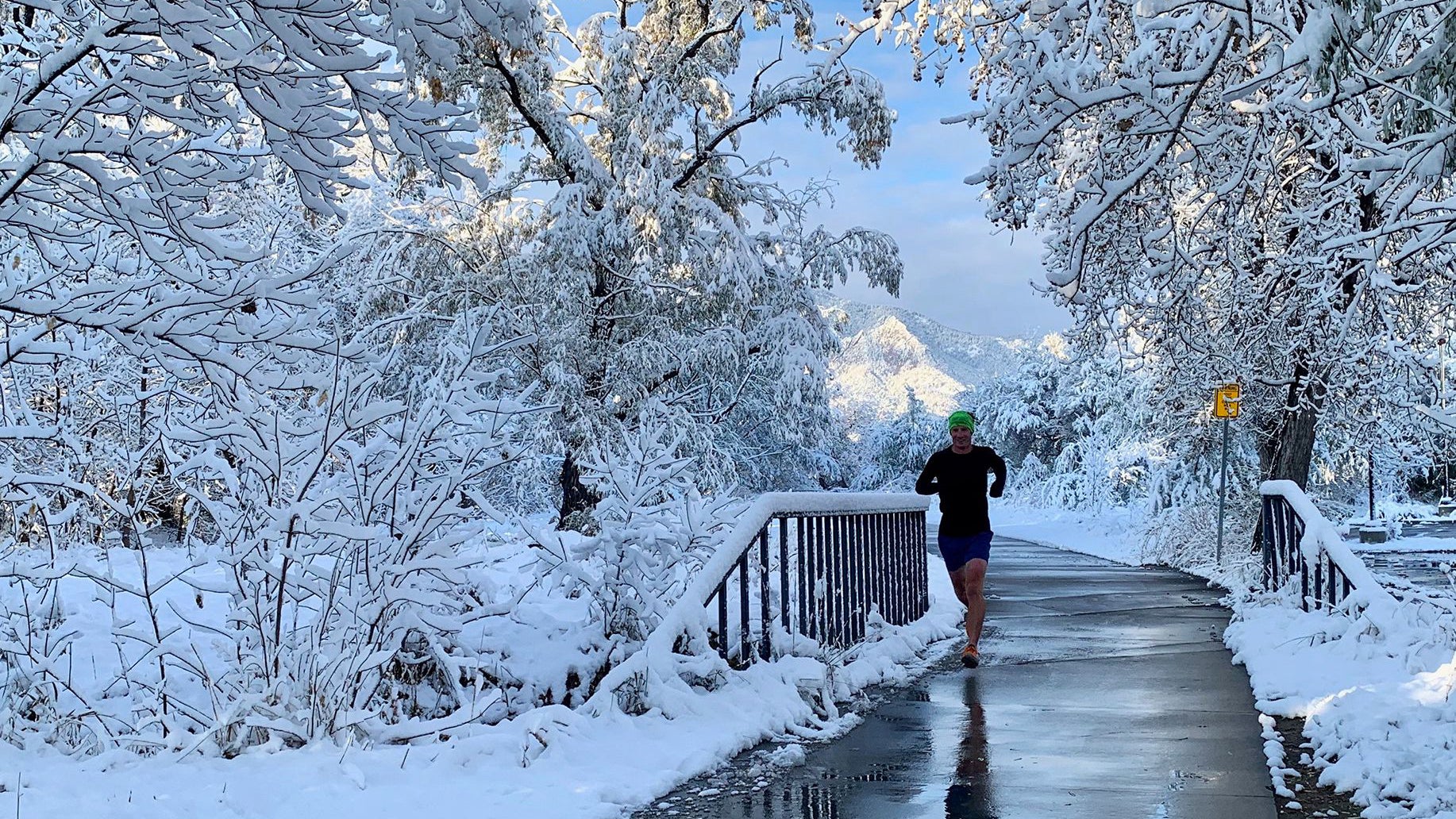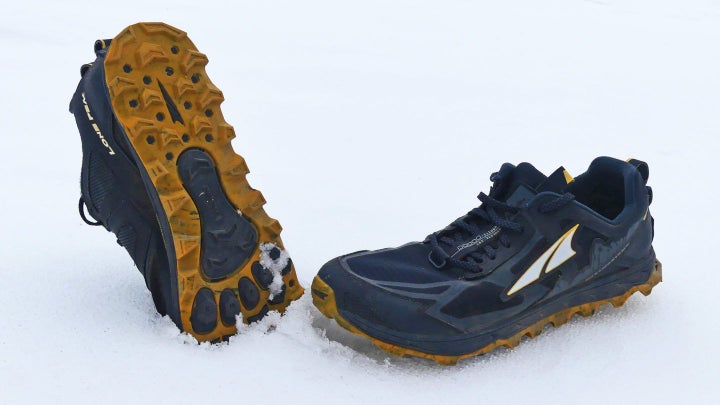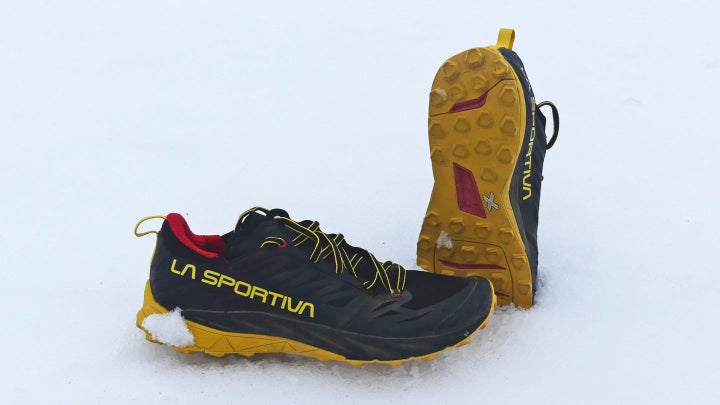If you buy through our links, we may earn an affiliate commission. This supports our mission to get more people active and outside.Learn about Outside Online's affiliate link policy
What Are the Best Winter Running Shoes?

Photo: 101 Degrees West
One of the beautiful qualities of snow is that it miraculously turns roads, paths, even tracks into trails. One of the not-so-beautiful aspects of snow is that it converts many surfaces into luge courses or mud baths, which leaves athletes wondering what are the best winter running shoes? Trail shoes are the answer.
The Best Winter Running Shoes Get a Grip
From the frozen ground up, trail shoes are better suited for winter running because they are designed and built with an emphasis on traction. Not only do trail running shoes have more substantial tread patterns and aggressive, deep lugs, but they are constructed with grippy materials for greater adhesion when trails or roads are wet or otherwise slick.
Many trail shoe brands, such as La Sportiva, Salomon, Merrell, and The North Face, emanate from the outdoor industry and have always emphasized their mountain heritage, with long-standing ties to rubber advances that better enhance traction on rock, wet surfaces and ice and snow as well. Some, such as models from Salomon or Icebug, even come with carbide studs built into the soles. Similarly, select Saucony models deploy Vibram’s Arctic Grip to provide better purchase on wet ice for thawing conditions.
The Best Winter Running Shoes Provide Protection Aplenty
Another reason trail shoes make excellent winter shoes for both road and trail: their uppers are often burly and reinforced. Winter elements of cold, snow, slush, wet, and mud go right through the woven mesh uppers of road shoes designed to vent on summer days.
The primary reason for building trail shoe uppers with more rugged materials and multiple overlays is to increase durability and protect the foot—creating armored vehicles, as it were. But there is also the benefit of shielding against the cold and providing a level of insulation. Even warmer are the trail shoes that come with Gore-Tex or other waterproof barriers built-in for dryness. Many trail shoe uppers also feature gaiter attachments to keep snow or ice from penetrating the ankle collar.
When the Going Gets Tough
When the temps drop below freezing many midsoles, especially those made of EVA, the traditional midsole foam, have different impact absorbing and energy-returning qualities than they do when the weather is warmer. Basically, the foam gets stiffer and that affects the elasticity, so the ride is less flexible, impact dampening or resilient. Studies have shown that when it is cold enough, a running shoe will perform as though it had been worn for hundreds of miles even though it is relatively new.
Many trails shoes take temperature into consideration and are built on midsole platforms with altered chemical qualities so that they retain their absorption and resilience in a much broader range of temperatures. For example, neither adidas Boost, which consists of hundreds of encapsulated thermoplastic polyurethane particles, nor Skechers Hyper Burst, which is like a risen dough that originated as a solid plastic exposed to CO2 gas when it is in its liquid state, are as negatively affected by cold as EVA. Their cushioning and bounce feel fresh, even if your muscles may aren’t as springy in sub-zero temps.
Numb Digits
Trying to tie or untie your shoes while wearing mittens, gloves or with fingers numbed from the cold can be an impossible task. That’s where speed lacing, Velcro or BOA’s dial-in security systems really shine. They allow you to lock your foot in place and, when you return from your run, quickly release your feet, even when you lack dexterity.
The Best Winter Running Shoes Reviewed
We review four trail shoes with rides smooth enough for roads plus enough traction and protection to handle a variety of trails.
Review: Altra Lone Peak 4.5

Weight: 10.5 oz (M); 8.7 oz (W)
Drop: ~0mm
$120, Roadrunnersports.com
Why it’s one of the best winter running shoes: A well-balanced, versatile trail shoe with foot-shaped comfort and zero-drop midsole—now with a better fit and firmer ride.
The Lone Peak serves as Altra’s middle-of-the-line trail shoe, providing more cushioning and support than the lightweight Superior, but more agility than the trail-swallowing Olympus. As such, the shoe tends to be versatile, allowing you to run a few miles on roads to a trail, where the aggressive lugs and rock plate provide plenty of protection. This half-step update (.5) doesn’t change how the Lone Peak fits into the line, but does alter the feel and ride, pushing it farther toward the nimble, close-to-the-ground end of the spectrum.
The visible aspect of the update comes in the upper, where overlays have been reduced, the tongue’s tie-in improved, and the lacing system simplified—dropping the complex looped eyelets of the 4.0. The result is a simpler, snugger wrap of the heel and midfoot, plus a slight savings in weight. Testers appreciated the update, one noting, “The snug feel on the heel with the wider toe box make for a great fit.”
Underfoot, Altra says that the “midsole foam has been tweaked just enough to give you a more resilient feel.” On the run, however, the tweaking gave the midsole a firmer feel, making the ride feel closer and more connected to the ground, even if the stack height remained 25mm. The Lone Peak has always been deceptively responsive—this version feels faster, with little squish and no slop underfoot. The change didn’t affect how testers reacted to the shoe much—they appreciated the moderate cushioning, the comfort of the foot-shaped last, and exceptional traction. One noted, “Ran on icy, slushy conditions without issues,” and said that the shoe made him feel, “in control and confident.”
Review: INOV-8 TRAILROC G 280

Weight: 9.9 oz (M)
Drop: ~8mm
$150, Roadrunnersports.com
Why it’s one of the best winter running shoes: A snappy, versatile, durable ride, best suited for narrow-toed runners.
The “G” in the name of INOV-8’s TRAILROC G 280 refers to graphene, a material made from graphite that is touted to be “200 times stronger than steel.” Graphene is incorporated in the outsole rubber of this trail shoe, so you don’t have to worry about your soles wearing out.
You probably won’t notice the graphene on the run, but you will quickly notice the snappy ride of the TRAILROC G 280. If you flex the toe, you’ll see that it bends easily, then pops back quickly like a track spike. This is due to the embedded META-PLATE, a shank that doubles as a rock-plate and gives INOV-8s their distinctive, quick-footed feel.
While many of the brand’s shoes are deeply studded, designed for navigating the muddy hills of their English lake-district origins, the TRAILROC G 280 has a relatively flat sole with multiple 4mm lugs. Combined with the moderate layer of responsive cushioning, the shoe can carry you versatilely from paved surfaces to packed trails.
Testers universally appreciated the “agile and protective” ride, but several had beefs with the fit. The upper is both well-padded and flexible, but narrows significantly in the toe. One tester was unable to run in them after a few tries due to rubbing on the sides of the reinforced toe cap. Another narrow-footed runner, however, said, “It was a secure, snug fit that allowed for confidence on technical terrain.” Best to try them before buying, and perhaps size up a half step.
Review: La Sportiva Kaptiva

Weight: 9 oz (M); 7.9 oz (W)
Drop: ~6mm
$140, Rei.com
Why it’s one of the best winter running shoes: Foot-hugging and ground-gripping security, with just the right amount of protection.
Slipping into the Kaptiva feels like pulling on a compression sock—you think it is too tight, then your foot falls into place and it feels remarkably supportive but not constrictive, completely held in place yet flexing easily where you need to. The Italian brand La Sportiva is known for its climbing shoes, and you feel like you could scramble up the side of a mountain given the security of the stretchy knit upper, sock-like tongue wrap and molded support underfoot. Yet you can also comfortably run to the mountain in these versatile, smooth-running shoes.
It’s high praise to say the sole attracts little attention—it just works. The stack height is low but not minimal, with a moderate 6mm drop. The midsole is neither soft nor firm, and flexes nicely in the forefoot, despite a thin embedded rock plate. Gripping the trail is a proprietary sticky-rubber compound (remember, this is a climbing company) with low, versatile lugs that worked well on slick, sloppy or snowy conditions.
Testers were universally positive, with comments like, “Great feel for the trail without forfeiting protection.” “Very capable on technical trails.” “Enough support that I didn’t feel every rock and surface underfoot and felt like I was in control of my footing through some tricky areas.”
Review: Topo MT-3

Weight: 9.9 oz (M); 8 oz (W)
Drop: ~3mm
$110, Rei.com
Why it’s one of the best winter running shoes: Simple, comfortable, versatile and capable shoe for those who like their shoes to get out of the way and disappear.
Some shoes shout at you, demanding attention with their flashy features. Others disappear and just do their job. The Topo MT-3 is the latter: A simple shoe that you rarely notice but find yourself wearing most days.
The comfort starts with the fit, which stems from Topo’s accommodating shape. “The toe box is roomy and gives the toes plenty of space to wiggle and move,” said one tester. A well-padded heel collar and tongue gives way to a simple rip-stop upper with a few strategic overlays. One tester said they had “a very minimalist fit and feel,” yet another assured that, “Nothing was too flimsy or too tight.”
The sole is flexible and unobtrusive; moderately-cushioned, moderately-firm. “It hits a good middle ground,” one tester said, while another called the cushioning, “just enough.” But the ride and 3mm drop was too close to the ground for one who found she started to hurt on longer runs. All, however, liked the traction. “Fantastic grip that made me feel invincible on rocky and gravelly terrain,” said the same tester. Another raved, “I think these are my new go-to’s for singletrack. Fit is great, traction is great, toe protection is great.”
As well as they perform on the trail, the shoes shone for their versatility on any surface or in any context. “Made me feel capable,” one tester summed up. “I like the idea of wearing these shoes on a short trail run, then going to lunch afterward without changing out of them.”
Looking for shoes that can handle the long trail or some that are a little bit lighter? Visit Podiumrunner.com for more reviews of the best winter running shoes.